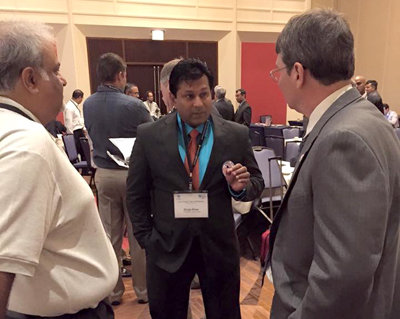On Saturday, August 29, the International Cricket Council hosted an all-day meeting at the Hyatt Regency at O’Hare Airport in Chicago. Over eighty American cricket stakeholders were in attendance, as were ICC CEO David Richardson, Global Development Manager Tim Anderson, ICC Americas Regional Development Manager Ben Kavenagh, and his staff from the Americas office in Toronto.

Shuja Kkan and Jamie Harrison having a chat while at the town hall meeting held by ICC. Photo source: Fita Shaikh
What struck me most at the meeting was the air of collegiality and camaraderie that was evident among the participants throughout the day. In some ways, it felt to me like a high school reunion, with old friends coming together after too many years apart, catching up on news and swapping old stories.
I know that USA cricket has a reputation as a fractious, disagreeable, and ultimately unmanageable collection of self-interested partisans, but none of that was seen on Saturday. What was seen instead was a harmonious determination by a diverse group of leaders to work together to save the game in America. Affiliations and past conflicts were put aside for the good of cricket; it was as close to a display of an administrative “spirit of cricket” as one could imagine.
This is especially significant when one considers the potentially divisive issues that the group was asked to discuss, issues that have crippled the development of cricket in America for decades. Opinions were frankly offered and debated, but always in a spirit of mutual respect and cooperation.
International cricket commentator and broadcaster Mike Haysman acted as Master of Ceremonies for the meeting, which, after introductions were made, began with Richardson explaining the timeline of USACA’s suspension, and the ICC’s commitment to the United States. Kavenagh then provided concrete facts and figures that demonstrated the wealth of unfulfilled potential in USA cricket.
The most important presentation of the day, in my opinion, was given by Dan Migala, who has advised Cricket Australia, plus organizations in MLB, NHL, NFL, NBA, NCAA, and MLS, on issues related to non-traditional revenue generation, sponsorship, technology and sports marketing. Migala presented a detailed and well-researched examination of the marketing of soccer in the United States, and how those lessons need to be applied to cricket. We always talk about a lack of funding holding back the game in America, but Dan correctly pointed out that “…revenue is a result, not an objective” of successful sports administration.
During the meeting, there was a session where breakout groups deliberated on the implications of survey results received from participants, and lots of time was allowed for questions to be posed to both the ICC and those working through the Local Advisory Group. Many of these questions were hard-hitting (and not shied away from by those on the receiving end, by the way), and many asked questions that dealt with our expectations for this process in the coming months. A light moment occurred when someone asked David Richardson, “What took you so long?”
The bottom line, in my view, is not that any concrete decisions came form Saturday’s meeting. What I saw on Saturday was Day One. It was proof that there is a large group of American cricket leaders who are willing to work together to make this a nation of cricket fans, and that we, for the most part, agree on the key issues that need to be addressed. Of course, developing a coherent strategy to address those issues will require much work and cooperation, but after Saturday, I see no reason now why that should not happen.
The past is the past, and what’s there must be left there. But the future is now in our hands, and the next, and perhaps most critical, chapter in the history of American cricket is about to be written. Our children and grandchildren will not give heed to excuses, but will judge us by what we do with this historic opportunity to set things right. Let’s not disappoint them.



